HOW I SPENT MY WEEKEND:
NRA TRAINING IN "PERSONAL PROTECTION OUTSIDE THE HOME"
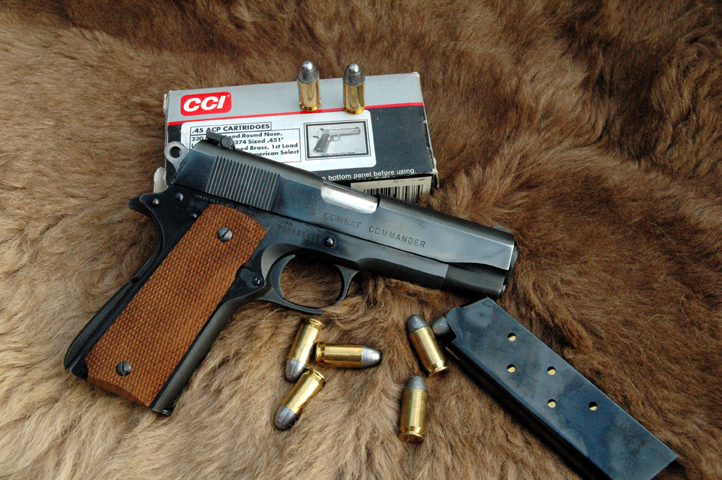 I'm a Certified Instructor for a variety of the NRA's firearms courses, and recently had to upgrade my certification status to reflect a re-organization of the courses NRA offers. What used to just be called "Personal Protection" was some years ago broken down into "Basic Pistol" and "Basics of Personal Protection." Then "Basic Pistol" was re-named "First Steps." About a year ago "Personal Protection" was subdivided into "Personal Protection Inside the Home" (PPITH) and "Personal Protection Outside The Home," which are pretty descriptive of the contents. The new course—PPOTH—concentrates on handling of firearms in Close Encounters Of The Violent Kind, especially on how to draw and shoot from a "concealment device," be that a holster, a holster-purse, or what have you. I'm now certified for all these courses, but had I not done the re-certification I'd not have been allowed to teach PPOTH.
I'm a Certified Instructor for a variety of the NRA's firearms courses, and recently had to upgrade my certification status to reflect a re-organization of the courses NRA offers. What used to just be called "Personal Protection" was some years ago broken down into "Basic Pistol" and "Basics of Personal Protection." Then "Basic Pistol" was re-named "First Steps." About a year ago "Personal Protection" was subdivided into "Personal Protection Inside the Home" (PPITH) and "Personal Protection Outside The Home," which are pretty descriptive of the contents. The new course—PPOTH—concentrates on handling of firearms in Close Encounters Of The Violent Kind, especially on how to draw and shoot from a "concealment device," be that a holster, a holster-purse, or what have you. I'm now certified for all these courses, but had I not done the re-certification I'd not have been allowed to teach PPOTH.
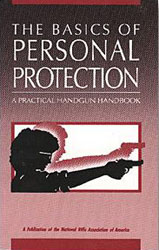 I started our club's courses about 18 years ago, back when there was only "Basics of Personal Protection," and have held some type of Instructor certification or another for nearly 40 years. I was more than a little annoyed that NRA has divvied up the courses and now asks me to pay a new certification fee for something I've been doing for them for a long time. After having gone through the certification for PPOTH, I'm glad I did it, but it was a grueling few days: up at 5:45 and home around 9:00 PM, as the range and classroom are considerable distances from my house. It's also expensive: the course costs $350, and I spent about $100 on ammunition. When I balked at paying that kind of money out of pocket, my club covered the course fee because the club's training officer strong-armed me and sweet-talked the club into funding it. I suppose I should be complimented by that. In order to teach the course you have to take the course, so the first of the three very long days was devoted to that: we instructor candidates were students in the course we would eventually teach. The second and third days were to "teach us how to teach," NRA style. Of this, more later.
I started our club's courses about 18 years ago, back when there was only "Basics of Personal Protection," and have held some type of Instructor certification or another for nearly 40 years. I was more than a little annoyed that NRA has divvied up the courses and now asks me to pay a new certification fee for something I've been doing for them for a long time. After having gone through the certification for PPOTH, I'm glad I did it, but it was a grueling few days: up at 5:45 and home around 9:00 PM, as the range and classroom are considerable distances from my house. It's also expensive: the course costs $350, and I spent about $100 on ammunition. When I balked at paying that kind of money out of pocket, my club covered the course fee because the club's training officer strong-armed me and sweet-talked the club into funding it. I suppose I should be complimented by that. In order to teach the course you have to take the course, so the first of the three very long days was devoted to that: we instructor candidates were students in the course we would eventually teach. The second and third days were to "teach us how to teach," NRA style. Of this, more later.

 The PPOTH course is very intensive and quite a bit of shooting is involved, far more than is the case with "First Steps" and PPITH. I burned up several hundred rounds of .45 ACP shooting it with my Combat Commander. Most of what I shot was reloads with cast bullets (a Lyman mold that casts a bullet more or less identical to the GI hardball in shape) and 4.5 grains of American Select shotgun powder. Parenthetically I'll note that I've used Unique for years, but have shifted to American Select for most handgun cartridges. It's as good as Unique and a whole lot cleaner: Unique is wonderful stuff for almost any medium caliber pistol, but it's phenomenally dirty. American Select was designed to burn with almost no residue and it does. Anyone who shoots a 9mm, .38 Super, or .45 ACP ought really to look into it.
The PPOTH course is very intensive and quite a bit of shooting is involved, far more than is the case with "First Steps" and PPITH. I burned up several hundred rounds of .45 ACP shooting it with my Combat Commander. Most of what I shot was reloads with cast bullets (a Lyman mold that casts a bullet more or less identical to the GI hardball in shape) and 4.5 grains of American Select shotgun powder. Parenthetically I'll note that I've used Unique for years, but have shifted to American Select for most handgun cartridges. It's as good as Unique and a whole lot cleaner: Unique is wonderful stuff for almost any medium caliber pistol, but it's phenomenally dirty. American Select was designed to burn with almost no residue and it does. Anyone who shoots a 9mm, .38 Super, or .45 ACP ought really to look into it.
At one point I did shoot a few of the courses of fire with my Mark VI Webley, just for Old Times' Sake. This did not please the trainer. At the post-course review he was very unhappy, told me I wasn't "focused" on the course material. This was not something I wanted to hear but I let him have his say: he was young enough to be my son, and in time he'll learn.
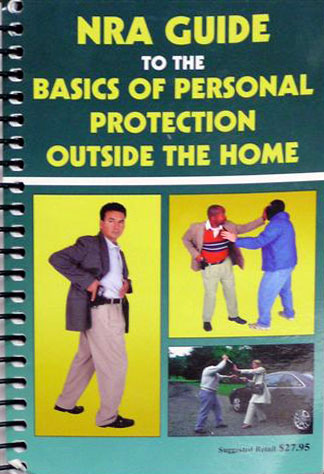
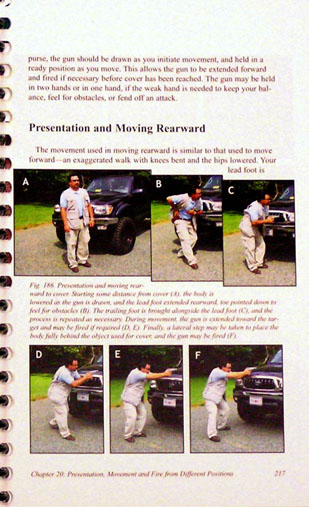 PPOTH concentrates on the sequence of events involved in drawing from concealment, mostly using strong-side hip holsters, but in the second and third days we did it from holster purses.
PPOTH concentrates on the sequence of events involved in drawing from concealment, mostly using strong-side hip holsters, but in the second and third days we did it from holster purses.
The steps in the drill, in succession, are ACCESS, PULL, ROTATE, JOIN, EXTEND, and FIRE. In this sequence you brush aside the "concealment garment" covering your "handgun concealment device" (ACCESS); remove the gun from the holster, pointed straight down (PULL); turn it to face the threat (ROTATE); bring your weak hand to the strong hand (JOIN); EXTEND the gun towards the target, pick up the sights, and FIRE. While you're doing this maneuver, the weak hand is held to the chest until the JOIN step, to get it out of the way of the muzzle. Once you get used to the movements required you can do this pretty smoothly and quickly, at least from a hip holster. Purses are another matter, as will be discussed below.
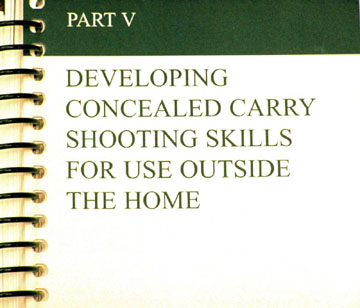 Everyone shot an autoloader. There were seven of us, three of whom used .45's (two Colt Combat Commanders) one used a 9mm Glock, and three .40 S&W's (two Glocks and a Beretta I-forget-the-model-number). We fired at 7 yards most of the time, but a couple of the exercises were literally held at arms-length distances of 2 yards, sometimes less. These latter are basically yank-and-shoot drills, with no time to take a sight picture, just poke the bad guy with the muzzle and fire (I call this the "Michael Corleone stance"). We were so close to the targets that lubricant from my bullets left spatters on the paper. Typically we fired one-shot drills, but sometimes were required to fire two in quick succession.
Everyone shot an autoloader. There were seven of us, three of whom used .45's (two Colt Combat Commanders) one used a 9mm Glock, and three .40 S&W's (two Glocks and a Beretta I-forget-the-model-number). We fired at 7 yards most of the time, but a couple of the exercises were literally held at arms-length distances of 2 yards, sometimes less. These latter are basically yank-and-shoot drills, with no time to take a sight picture, just poke the bad guy with the muzzle and fire (I call this the "Michael Corleone stance"). We were so close to the targets that lubricant from my bullets left spatters on the paper. Typically we fired one-shot drills, but sometimes were required to fire two in quick succession.
"Defensive accuracy" was all that was called for: this means keeping your all shots on an 8-1/2" x 11" sheet of paper. Anyone who can't do that at 7 yards or less really has no business carrying a gun anyway, to my way of thinking. There was one "extended range" drill in which we "engaged" a threat at 10 yards, but beyond that it would be difficult to explain to a judge why you had to shoot, we were told ("Because he 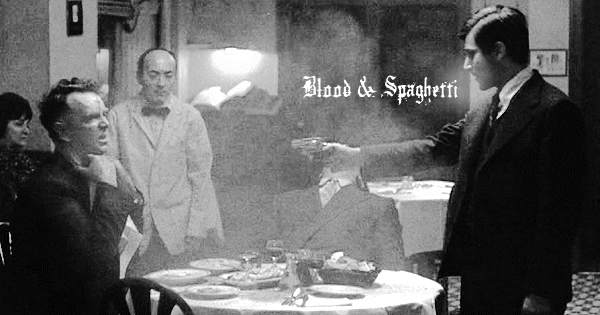 had a rifle, Your Honor!") so that was the limit. But overall the emphasis was on distances equivalent to inside an elevator or a parking garage stairwell. You don't need to be much of a marksman to hit a man at that sort of range, but keeping all your shots on the paper is harder than you might think, and it does require practice.
had a rifle, Your Honor!") so that was the limit. But overall the emphasis was on distances equivalent to inside an elevator or a parking garage stairwell. You don't need to be much of a marksman to hit a man at that sort of range, but keeping all your shots on the paper is harder than you might think, and it does require practice.
We also did some very valuable exercises on shooting from cover (high and low) and fast reloading, plus a "simulated night fire" in which we wore welding goggles. One drawback to this simulation is that the goggles completely hide the muzzle flash (a couple of days we were firing at dusk and the flashes were visible) but it did give you an idea of how tough it can be to pick up a target in dim light.
The second and third days we did the course for instructors, in which we were required to actually teach modules of what we'd done the day before. This entailed going through the lesson plans point by point, doing them EXACTLY as they were laid out in The Book, with the other instructor candidates as our "students." I hate role-playing exercises and much preferred being the "student" to being the "instructor" in these.
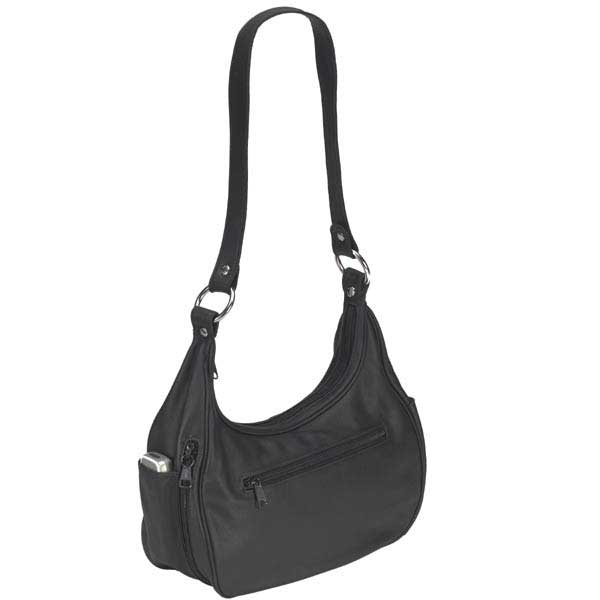 An innovation of the second and third days was the use of holster purses. They made this part of the course very frustrating because they're remarkably clumsy compared to a strong-side hip holster. I had never handled one of these things before, and there's a special technique to it, that is intended to prevent you from "sweeping" yourself with the muzzle; I wasn't very good at it, and frequently got my arm in the way of the muzzle, which did not please the trainer. When you have a heavy gun in a purse, it tends to do two things: first, it throws the purse off balance, and second, when you do the ACCESS step (in which you're supposed to pull the purse to your chest with the weak hand) there's a natural tendency to want to support the weight of the gun from underneath, not by the top strap. If you do this, when you draw the gun, you'll move the muzzle across your arm. I found it very difficult NOT to support the purse from underneath and got gigged by the trainer for doing so.
An innovation of the second and third days was the use of holster purses. They made this part of the course very frustrating because they're remarkably clumsy compared to a strong-side hip holster. I had never handled one of these things before, and there's a special technique to it, that is intended to prevent you from "sweeping" yourself with the muzzle; I wasn't very good at it, and frequently got my arm in the way of the muzzle, which did not please the trainer. When you have a heavy gun in a purse, it tends to do two things: first, it throws the purse off balance, and second, when you do the ACCESS step (in which you're supposed to pull the purse to your chest with the weak hand) there's a natural tendency to want to support the weight of the gun from underneath, not by the top strap. If you do this, when you draw the gun, you'll move the muzzle across your arm. I found it very difficult NOT to support the purse from underneath and got gigged by the trainer for doing so.
The real issue, though, is the difficulty of getting a handgun out of a purse holster smoothly.
Purse holsters are inherently awkward, and the close confines of the pistol pocket in most of them are such as to preclude the use of anything with projections or sharp edges. Nor are they really suited to carrying a gun the size of a Combat Commander. If I'd been shooting a de-horned .38 snub-nosed revolver it would have been a great deal easier, but a smallish purse and a Combat Commander are a bad mix.
 Quite aside from the problem of snagging, most of the examples we had seemed to be very poorly thought out: one had its carrying strap mounted off the centerline, so that the weight of the gun caused the bag to hang at an awkward angle. One purse had Velcro closures on the flap that were very weak: I was concerned about the gun falling out if the purse was turned sideways. Zippers are stronger, but I found you MUST have some sort of tactile clue to which zipper to pull when you ACCESS. These damned purses have zippers all over them and every zipper has a little leather thong on it; I solved that problem by removing all the thongs except the one on the zipper that opened the gun compartment. That at least gave me a way to tell by touch what zipper I was using. I also found that the location of the zipper pull with respect to the gun butt is absolutely crucial to a smooth draw. If it's too high up it slows you down, and if it's too low there's a tendency for the gun to open the zipper by its weight as the butt protrudes. Unless there's some sort of retention device inside, such as a separate holster Velcro-ed to the interior of the purse, the gun will be at an awkward angle, or worse, may fall out. Not every purse has such an internal holster; not every purse with one has a holster that's adjustable for angle and depth.
Quite aside from the problem of snagging, most of the examples we had seemed to be very poorly thought out: one had its carrying strap mounted off the centerline, so that the weight of the gun caused the bag to hang at an awkward angle. One purse had Velcro closures on the flap that were very weak: I was concerned about the gun falling out if the purse was turned sideways. Zippers are stronger, but I found you MUST have some sort of tactile clue to which zipper to pull when you ACCESS. These damned purses have zippers all over them and every zipper has a little leather thong on it; I solved that problem by removing all the thongs except the one on the zipper that opened the gun compartment. That at least gave me a way to tell by touch what zipper I was using. I also found that the location of the zipper pull with respect to the gun butt is absolutely crucial to a smooth draw. If it's too high up it slows you down, and if it's too low there's a tendency for the gun to open the zipper by its weight as the butt protrudes. Unless there's some sort of retention device inside, such as a separate holster Velcro-ed to the interior of the purse, the gun will be at an awkward angle, or worse, may fall out. Not every purse has such an internal holster; not every purse with one has a holster that's adjustable for angle and depth.
You also have to remember which way the gun is oriented in the purse and always carry it the right way, which, since the damn thing looks the same at both ends, isn't always easy. If you forget and have the purse turned 180 degrees from its proper position, you find yourself grasping the barrel instead of the butt of the gun, which is bad ju-ju, for sure.
Holster purses do give excellent concealment, but they also are inherently risky because you haven't got the gun on your person, and it's possible for a purse to be stolen or forgotten, and how would you like to explain THAT to the police if your gun turns up in a robbery?
The trainer was pretty good and obviously knowledgeable: a reserve cop and apparently he works for some sort of security-training outfit as a supplement to his day job as an engineer. He had on all the miscellaneous NRA logos but appeared to be a contractor. I'm a volunteer, and so were my classmates, but this guy is getting paid. How much I don't know, but at $325 per person, with 7 enrollees he probably took home 50%, call it $1000 for three days work, plus expenses. Not bad for a part time job.
He was something of a martinet, a By-The-Book type who was obviously scared stiff that NRA would land on him if he deviated in any way from The Party Line, and cost him that $300/day income. The "instruction" he provided in the classroom was deadly dull: soporific in the extreme. The class is conducted by "Total Participant Involvement," which the trainer interpreted (maybe he was told to interpret) as putting up a Powerpoint and having US read the Powerpoint to him, out loud. (This is, come to think of it, the manner in which my grade school teachers worked, except of course in the Stone Age we didn't have Powerpoint.) Everything (especially test answers) had to be word-for-word From The Book, no deviation, and God help you if you said "weapon" instead of "handgun" or "firearm," as The Book pointed out that "weapon" has "...a negative connotation." Well, duh, yes...I mean, we're being taught how to shoot people, but we can't say "weapon"? Nope, The Book says not to do so. The Book is Holy Writ.
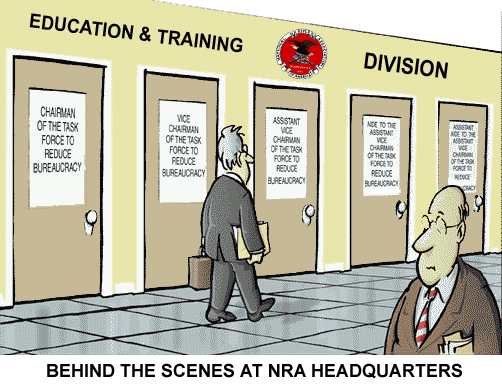 Regrettably, the NRA is a bureaucracy like any other, and worse than many. The course syllabus and the manual for it are clearly the product of years of revisions, re-writing, committee meetings, and consensus-building. While The Book covers the ground thoroughly and well, the student manual is hardly riveting stuff, and a slow, painful thing to plow through.
Regrettably, the NRA is a bureaucracy like any other, and worse than many. The course syllabus and the manual for it are clearly the product of years of revisions, re-writing, committee meetings, and consensus-building. While The Book covers the ground thoroughly and well, the student manual is hardly riveting stuff, and a slow, painful thing to plow through.
It has been said of the military that their training techniques are "A plan developed by geniuses for the education of idiots," and the hallmarks of the Department of Defense's education philosophy are all over this manual, and most especially on the training materials for training instructors. There is no permissible deviation from The Book, everything is broken down into small sub-units, no discussion of concepts is encouraged (and only barely tolerated) and Official NRA-Speak is the order of the day.
An example of how stupefying The Book can be is the phrase "...using a handgun for Personal Protection outside The Home..." from which you may not deviate, and which, in its entirety, can be (and often is) repeated five or six times in a single paragraph of the manual's text or in The Official Lesson Plans. Over and over and over. There are many other such Officially Approved Phrases than MUST be used in all their wordiness, and cannot in any way be abbreviated or modified. The course itself was NEVER referred to as "Personal Protection," as it once was: it was ALWAYS "Personal Protection Outside the Home," period. You couldn't, for example, call this course "Personal Defense Outside The Home," nor "Personal Protection Outside Your Home," and certainly not "Personal Protection." You can use the term "holster" ONLY if referring to a holster, specifically; if there is the merest possibility you may be applying your statement to a purse or something else, you have to say "handgun concealment device."
There is also clear evidence of intervention by NRA's Legal Affairs Division in the writing of the manual, proving their paranoia about liability lawsuits. We are NEVER, ever, EVER, to use the word "kill." We shoot to STOP an attack. If someone does get killed, the NRA is terrified that a prosecutor will say we "trained him to kill," so we train him to STOP. There are many more examples of weasel-wording inserted by the lawyers. Perhaps I've been spoiled by too many years of teaching intelligent and motivated students in an environment where, so long as I cover the material, the decisions on HOW to present it are mine and mine alone, but I found the constant repetition of hackneyed phrases and the stultifying business of rote recitation not only boring, but outright insulting. Maybe it can't be otherwise with this course, given the variety of people who sign up to be instructors, and the even wider variety of people they have to teach the material to, but I wish it could.
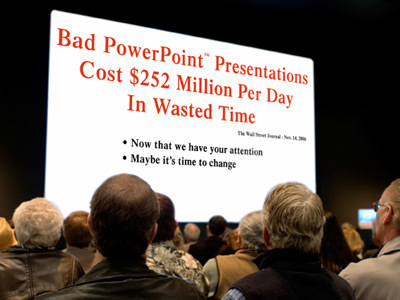
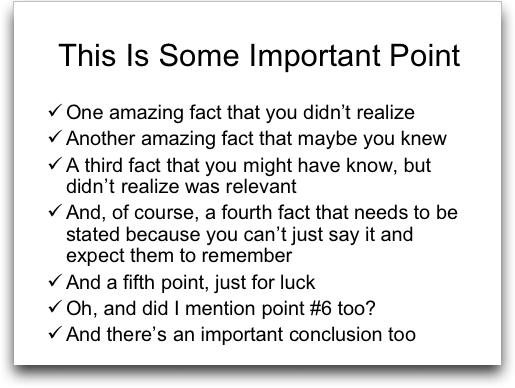 And then, I have this "thing" about Powerpoint, and how it should be used but almost never is. I use Powerpoint every day of my professional life. It's a stupendously useful and amazingly creative teaching technology, but what no one seems to grasp is that Powerpoint is a VISUAL medium. Powerpoint exists for the purpose of using images to get an idea across. The old saying about "One picture is worth 10,000 words," is 100% correct, and Powerpoint, properly used, is the very embodiment of this principle.
And then, I have this "thing" about Powerpoint, and how it should be used but almost never is. I use Powerpoint every day of my professional life. It's a stupendously useful and amazingly creative teaching technology, but what no one seems to grasp is that Powerpoint is a VISUAL medium. Powerpoint exists for the purpose of using images to get an idea across. The old saying about "One picture is worth 10,000 words," is 100% correct, and Powerpoint, properly used, is the very embodiment of this principle.
 But the key phrase there is "properly used," and damned few people—certainly not the trainer, nor the individual at NRA's Education & Training Division who put the Powerpoint together—do use it properly. The "presentations" are word for word transcriptions from The Book. Nothing drives me crazier than to have someone flash WORDS, lots of words, up on a screen and then READ them to me. A few words, a sort of skeletal outline, are fine, but there has to be some sort of visual interest, a picture to reinforce the message. This isn't hard to do, but it does require effort and creativity, and while effort is clearly not in short supply at NRA's E&T Division, creativity isn't their strong suit. In essence what we got was an entire damned BOOK up there, put up page by page, which we had to read OUT LOUD. If anything is designed to put an audience to sleep faster I don't know what it could be.
But the key phrase there is "properly used," and damned few people—certainly not the trainer, nor the individual at NRA's Education & Training Division who put the Powerpoint together—do use it properly. The "presentations" are word for word transcriptions from The Book. Nothing drives me crazier than to have someone flash WORDS, lots of words, up on a screen and then READ them to me. A few words, a sort of skeletal outline, are fine, but there has to be some sort of visual interest, a picture to reinforce the message. This isn't hard to do, but it does require effort and creativity, and while effort is clearly not in short supply at NRA's E&T Division, creativity isn't their strong suit. In essence what we got was an entire damned BOOK up there, put up page by page, which we had to read OUT LOUD. If anything is designed to put an audience to sleep faster I don't know what it could be.
The trainer was not only critical of me for using two guns (he felt this was not By The Book) he felt I was "unsafe" because when my Commander jammed, I went 20 yards behind the line, stripped it down, and fixed it, being careful of course to point the gun away from the line, and towards the ground. What he expected me to do I have no idea: maybe point my finger and say BANG? No, I couldn't have that...it's not in The Book.
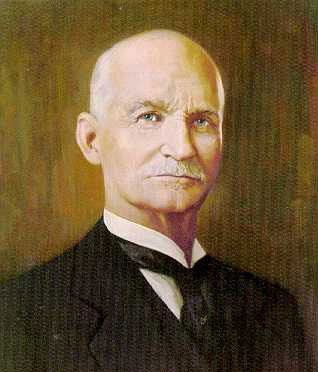 I stand in awe of the genius of John M. Browning: his design has been with us almost a century, and in my opinion no one has improved on it. The late Col. Jeff Cooper, who had far more experience than I in combat with handguns, was of the same opinion. I wouldn't object to carrying a Glock or Glock-derivative, but given a choice between one of those and a 1911-style pistol, I'll take the Colt every time, all other things being equal.
I stand in awe of the genius of John M. Browning: his design has been with us almost a century, and in my opinion no one has improved on it. The late Col. Jeff Cooper, who had far more experience than I in combat with handguns, was of the same opinion. I wouldn't object to carrying a Glock or Glock-derivative, but given a choice between one of those and a 1911-style pistol, I'll take the Colt every time, all other things being equal.
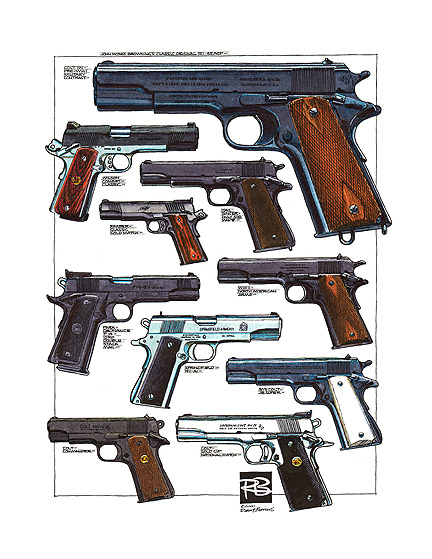 I hadn't shot that Commander in a long time, and had forgotten how much I liked it. It's one fine pistol, though the last time I wore it for any significant length of time in an inside-the-waistband holster it about pulled my britches down and when I took it off I felt like I was floating; 39 ounces empty, plus 8 rounds of .45 ACP is a LOT of weight. Nevertheless, it's accurate, reliable, and ergonomically as close to perfect as a gun can get. I have heard a lot about how double-action autoloaders are the wave of the future (or the present) but John Browning's old Hoss Pistol will do the job. A first-shot-double-action pistol is no faster to deploy, coming out of the holster, than is a single-action 1911 type gun carried in Condition One.
I hadn't shot that Commander in a long time, and had forgotten how much I liked it. It's one fine pistol, though the last time I wore it for any significant length of time in an inside-the-waistband holster it about pulled my britches down and when I took it off I felt like I was floating; 39 ounces empty, plus 8 rounds of .45 ACP is a LOT of weight. Nevertheless, it's accurate, reliable, and ergonomically as close to perfect as a gun can get. I have heard a lot about how double-action autoloaders are the wave of the future (or the present) but John Browning's old Hoss Pistol will do the job. A first-shot-double-action pistol is no faster to deploy, coming out of the holster, than is a single-action 1911 type gun carried in Condition One.
Glocks...well, I have shot them and will freely admit that they're excellent shooters and pretty much trouble free, but the absence of the manual safety really bothers me. I know several people, including a Roanoke police officer, who have had accidental discharges (or nearly so, i.e, a "click" in a dry fire drill) with a Glock that couldn't have happened with any other design. The Glock "safety" in the trigger isn't a safety at all, most especially if your shirt-tail gets stuck in it when reholstering, or if you break training and forget to take your finger out of the trigger guard. Theoretically, shooting yourself in the ass is possible with a double-action revolver; but it started to happen with fair regularity after police departments began to issue Glocks. The heavy "New York" trigger was developed in part to curb an epidemic of butt-shooting on the part of NYPD officers when they started using Glocks 10 years ago. A thumb safety would solve this problem.
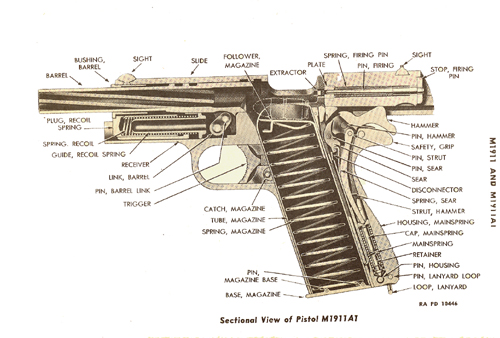 The position of the thumb safety alone is a stroke of brilliance. Putting it on or off is completely instinctive, requires no fumbling, and can be done in a fraction of a second. The slide-mounted de-cocker "safeties" of newer guns make me jump whenever I push the lever and the hammer drops. I'll never get used to that. I simply don't understand why any gun equipped with a safety catch at all would have it anywhere else but under the shooter's thumb. Nowadays the preferred position seems to be to put it on the slide, which absolutely requires two hands to manipulate. Even worse is the safety catch mounted in front of the trigger guard, a la Eibar-type autoloaders, which is flat-out impossible to reach if you have small hands.
The position of the thumb safety alone is a stroke of brilliance. Putting it on or off is completely instinctive, requires no fumbling, and can be done in a fraction of a second. The slide-mounted de-cocker "safeties" of newer guns make me jump whenever I push the lever and the hammer drops. I'll never get used to that. I simply don't understand why any gun equipped with a safety catch at all would have it anywhere else but under the shooter's thumb. Nowadays the preferred position seems to be to put it on the slide, which absolutely requires two hands to manipulate. Even worse is the safety catch mounted in front of the trigger guard, a la Eibar-type autoloaders, which is flat-out impossible to reach if you have small hands.
If the 1911 design has a flaw—which I'm not about to admit—it's the dual use of the thumb safety as a slide lock. This is due to its origins as a cavalryman's pistol: it's to keep the slide from being opened when reholstering. It's a very small issue, however, and of course it serves the same purpose even if you're not on a horse.
Similarly, the heel-type magazine catch typical of most European service pistols is slow and awkward compared to the frame-mounted button behind the trigger guard, another of JMB's innovations. You can't do a fast magazine change with, say, a P-38 or Luger. You can't drop a magazine from those guns, you must pull it out with two hands. Heel catches are slowly going out of use, though, most makers having recognized the advantage the frame button affords.
In the three days of shooting I had one misfire, and two jams that required clearing; the latter were due to deformation of the neoprene recoil spring buffer I'd installed in the CC to prevent frame damage from hot loads. Repeated bashing of the buffer by the slide squeezed it out to where it was oozing "flash" and binding the slide, but a new buffer fixed that. Some gun gurus advise against the use of a buffer at all exactly for this reason, and recommend a stiffer recoil spring.
Bottom line: the course was valuable and will serve me well in the future. The NRA's anal retentiveness aside, the course material is valuable and I did learn some things that are going to be applied to my own "Personal Protection Outside The Home" and which I'll pass along to my students. The most valuable thing I took away from this class is how difficult it is to use a purse holster.
Women have a real problem with concealed carry, because women's clothing usually isn't properly designed for concealment of anything, let alone a weapon; and their anatomical arrangements make hip holsters and shoulder holsters problematic. Many of them more or less assume they should have a holster purse, and realistically that's probably the case.
I'm glad I don't have that issue, but since most of the people who take the course are women, I need to look at some holster purses and see whether I can find one I like and can recommend to them. I would never, ever, buy a holster purse without actually handling it with the gun I planned to carry in it; and I'd advise anyone thinking of one of these (or the men's equivalent, a holster/briefcase or holster/portfolio) to not go for a cheap knock-off. Get a good one, try before you buy, and practice, practice, practice with it. None of the ones we used in the course were very good.
| HUNTING | GUNS | DOGS |
| FISHING & BOATING | TRIP REPORTS | MISCELLANEOUS ESSAYS |
| CONTRIBUTIONS FROM OTHER WRITERS|
| RECIPES |POLITICS |
 I'm a Certified Instructor for a variety of the NRA's firearms courses, and recently had to upgrade my certification status to reflect a re-organization of the courses NRA offers. What used to just be called "Personal Protection" was some years ago broken down into "Basic Pistol" and "Basics of Personal Protection." Then "Basic Pistol" was re-named "First Steps." About a year ago "Personal Protection" was subdivided into "Personal Protection Inside the Home" (PPITH) and "Personal Protection Outside The Home," which are pretty descriptive of the contents. The new course—PPOTH—concentrates on handling of firearms in Close Encounters Of The Violent Kind, especially on how to draw and shoot from a "concealment device," be that a holster, a holster-purse, or what have you. I'm now certified for all these courses, but had I not done the re-certification I'd not have been allowed to teach PPOTH.
I'm a Certified Instructor for a variety of the NRA's firearms courses, and recently had to upgrade my certification status to reflect a re-organization of the courses NRA offers. What used to just be called "Personal Protection" was some years ago broken down into "Basic Pistol" and "Basics of Personal Protection." Then "Basic Pistol" was re-named "First Steps." About a year ago "Personal Protection" was subdivided into "Personal Protection Inside the Home" (PPITH) and "Personal Protection Outside The Home," which are pretty descriptive of the contents. The new course—PPOTH—concentrates on handling of firearms in Close Encounters Of The Violent Kind, especially on how to draw and shoot from a "concealment device," be that a holster, a holster-purse, or what have you. I'm now certified for all these courses, but had I not done the re-certification I'd not have been allowed to teach PPOTH.  I started our club's courses about 18 years ago, back when there was only "Basics of Personal Protection," and have held some type of Instructor certification or another for nearly 40 years. I was more than a little annoyed that NRA has divvied up the courses and now asks me to pay a new certification fee for something I've been doing for them for a long time. After having gone through the certification for PPOTH, I'm glad I did it, but it was a grueling few days: up at 5:45 and home around 9:00 PM, as the range and classroom are considerable distances from my house. It's also expensive: the course costs $350, and I spent about $100 on ammunition. When I balked at paying that kind of money out of pocket, my club covered the course fee because the club's training officer strong-armed me and sweet-talked the club into funding it. I suppose I should be complimented by that. In order to teach the course you have to take the course, so the first of the three very long days was devoted to that: we instructor candidates were students in the course we would eventually teach. The second and third days were to "teach us how to teach," NRA style. Of this, more later.
I started our club's courses about 18 years ago, back when there was only "Basics of Personal Protection," and have held some type of Instructor certification or another for nearly 40 years. I was more than a little annoyed that NRA has divvied up the courses and now asks me to pay a new certification fee for something I've been doing for them for a long time. After having gone through the certification for PPOTH, I'm glad I did it, but it was a grueling few days: up at 5:45 and home around 9:00 PM, as the range and classroom are considerable distances from my house. It's also expensive: the course costs $350, and I spent about $100 on ammunition. When I balked at paying that kind of money out of pocket, my club covered the course fee because the club's training officer strong-armed me and sweet-talked the club into funding it. I suppose I should be complimented by that. In order to teach the course you have to take the course, so the first of the three very long days was devoted to that: we instructor candidates were students in the course we would eventually teach. The second and third days were to "teach us how to teach," NRA style. Of this, more later.
 The PPOTH course is very intensive and quite a bit of shooting is involved, far more than is the case with "First Steps" and PPITH. I burned up several hundred rounds of .45 ACP shooting it with my Combat Commander. Most of what I shot was reloads with cast bullets (a Lyman mold that casts a bullet more or less identical to the GI hardball in shape) and 4.5 grains of American Select shotgun powder. Parenthetically I'll note that I've used Unique for years, but have shifted to American Select for most handgun cartridges. It's as good as Unique and a whole lot cleaner: Unique is wonderful stuff for almost any medium caliber pistol, but it's phenomenally dirty. American Select was designed to burn with almost no residue and it does. Anyone who shoots a 9mm, .38 Super, or .45 ACP ought really to look into it.
The PPOTH course is very intensive and quite a bit of shooting is involved, far more than is the case with "First Steps" and PPITH. I burned up several hundred rounds of .45 ACP shooting it with my Combat Commander. Most of what I shot was reloads with cast bullets (a Lyman mold that casts a bullet more or less identical to the GI hardball in shape) and 4.5 grains of American Select shotgun powder. Parenthetically I'll note that I've used Unique for years, but have shifted to American Select for most handgun cartridges. It's as good as Unique and a whole lot cleaner: Unique is wonderful stuff for almost any medium caliber pistol, but it's phenomenally dirty. American Select was designed to burn with almost no residue and it does. Anyone who shoots a 9mm, .38 Super, or .45 ACP ought really to look into it.
 PPOTH concentrates on the sequence of events involved in drawing from concealment, mostly using strong-side hip holsters, but in the second and third days we did it from holster purses.
PPOTH concentrates on the sequence of events involved in drawing from concealment, mostly using strong-side hip holsters, but in the second and third days we did it from holster purses. Everyone shot an autoloader. There were seven of us, three of whom used .45's (two Colt Combat Commanders) one used a 9mm Glock, and three .40 S&W's (two Glocks and a Beretta I-forget-the-model-number). We fired at 7 yards most of the time, but a couple of the exercises were literally held at arms-length distances of 2 yards, sometimes less. These latter are basically yank-and-shoot drills, with no time to take a sight picture, just poke the bad guy with the muzzle and fire (I call this the "Michael Corleone stance"). We were so close to the targets that lubricant from my bullets left spatters on the paper. Typically we fired one-shot drills, but sometimes were required to fire two in quick succession.
Everyone shot an autoloader. There were seven of us, three of whom used .45's (two Colt Combat Commanders) one used a 9mm Glock, and three .40 S&W's (two Glocks and a Beretta I-forget-the-model-number). We fired at 7 yards most of the time, but a couple of the exercises were literally held at arms-length distances of 2 yards, sometimes less. These latter are basically yank-and-shoot drills, with no time to take a sight picture, just poke the bad guy with the muzzle and fire (I call this the "Michael Corleone stance"). We were so close to the targets that lubricant from my bullets left spatters on the paper. Typically we fired one-shot drills, but sometimes were required to fire two in quick succession.  had a rifle, Your Honor!") so that was the limit. But overall the emphasis was on distances equivalent to inside an elevator or a parking garage stairwell. You don't need to be much of a marksman to hit a man at that sort of range, but keeping all your shots on the paper is harder than you might think, and it does require practice.
had a rifle, Your Honor!") so that was the limit. But overall the emphasis was on distances equivalent to inside an elevator or a parking garage stairwell. You don't need to be much of a marksman to hit a man at that sort of range, but keeping all your shots on the paper is harder than you might think, and it does require practice.  An innovation of the second and third days was the use of holster purses. They made this part of the course very frustrating because they're remarkably clumsy compared to a strong-side hip holster. I had never handled one of these things before, and there's a special technique to it, that is intended to prevent you from "sweeping" yourself with the muzzle; I wasn't very good at it, and frequently got my arm in the way of the muzzle, which did not please the trainer. When you have a heavy gun in a purse, it tends to do two things: first, it throws the purse off balance, and second, when you do the ACCESS step (in which you're supposed to pull the purse to your chest with the weak hand) there's a natural tendency to want to support the weight of the gun from underneath, not by the top strap. If you do this, when you draw the gun, you'll move the muzzle across your arm. I found it very difficult NOT to support the purse from underneath and got gigged by the trainer for doing so.
An innovation of the second and third days was the use of holster purses. They made this part of the course very frustrating because they're remarkably clumsy compared to a strong-side hip holster. I had never handled one of these things before, and there's a special technique to it, that is intended to prevent you from "sweeping" yourself with the muzzle; I wasn't very good at it, and frequently got my arm in the way of the muzzle, which did not please the trainer. When you have a heavy gun in a purse, it tends to do two things: first, it throws the purse off balance, and second, when you do the ACCESS step (in which you're supposed to pull the purse to your chest with the weak hand) there's a natural tendency to want to support the weight of the gun from underneath, not by the top strap. If you do this, when you draw the gun, you'll move the muzzle across your arm. I found it very difficult NOT to support the purse from underneath and got gigged by the trainer for doing so.  Quite aside from the problem of snagging, most of the examples we had seemed to be very poorly thought out: one had its carrying strap mounted off the centerline, so that the weight of the gun caused the bag to hang at an awkward angle. One purse had Velcro closures on the flap that were very weak: I was concerned about the gun falling out if the purse was turned sideways. Zippers are stronger, but I found you MUST have some sort of tactile clue to which zipper to pull when you ACCESS. These damned purses have zippers all over them and every zipper has a little leather thong on it; I solved that problem by removing all the thongs except the one on the zipper that opened the gun compartment. That at least gave me a way to tell by touch what zipper I was using. I also found that the location of the zipper pull with respect to the gun butt is absolutely crucial to a smooth draw. If it's too high up it slows you down, and if it's too low there's a tendency for the gun to open the zipper by its weight as the butt protrudes. Unless there's some sort of retention device inside, such as a separate holster Velcro-ed to the interior of the purse, the gun will be at an awkward angle, or worse, may fall out. Not every purse has such an internal holster; not every purse with one has a holster that's adjustable for angle and depth.
Quite aside from the problem of snagging, most of the examples we had seemed to be very poorly thought out: one had its carrying strap mounted off the centerline, so that the weight of the gun caused the bag to hang at an awkward angle. One purse had Velcro closures on the flap that were very weak: I was concerned about the gun falling out if the purse was turned sideways. Zippers are stronger, but I found you MUST have some sort of tactile clue to which zipper to pull when you ACCESS. These damned purses have zippers all over them and every zipper has a little leather thong on it; I solved that problem by removing all the thongs except the one on the zipper that opened the gun compartment. That at least gave me a way to tell by touch what zipper I was using. I also found that the location of the zipper pull with respect to the gun butt is absolutely crucial to a smooth draw. If it's too high up it slows you down, and if it's too low there's a tendency for the gun to open the zipper by its weight as the butt protrudes. Unless there's some sort of retention device inside, such as a separate holster Velcro-ed to the interior of the purse, the gun will be at an awkward angle, or worse, may fall out. Not every purse has such an internal holster; not every purse with one has a holster that's adjustable for angle and depth.  Regrettably, the NRA is a bureaucracy like any other, and worse than many. The course syllabus and the manual for it are clearly the product of years of revisions, re-writing, committee meetings, and consensus-building. While The Book covers the ground thoroughly and well, the student manual is hardly riveting stuff, and a slow, painful thing to plow through.
Regrettably, the NRA is a bureaucracy like any other, and worse than many. The course syllabus and the manual for it are clearly the product of years of revisions, re-writing, committee meetings, and consensus-building. While The Book covers the ground thoroughly and well, the student manual is hardly riveting stuff, and a slow, painful thing to plow through.  And then, I have this "thing" about Powerpoint, and how it should be used but almost never is. I use Powerpoint every day of my professional life. It's a stupendously useful and amazingly creative teaching technology, but what no one seems to grasp is that
And then, I have this "thing" about Powerpoint, and how it should be used but almost never is. I use Powerpoint every day of my professional life. It's a stupendously useful and amazingly creative teaching technology, but what no one seems to grasp is that  But the key phrase there is "properly used," and damned few people—certainly not the trainer, nor the individual at NRA's Education & Training Division who put the Powerpoint together—do use it properly. The "presentations" are word for word transcriptions from The Book. Nothing drives me crazier than to have someone flash WORDS, lots of words, up on a screen and then READ them to me. A few words, a sort of skeletal outline, are fine, but there has to be some sort of visual interest, a picture to reinforce the message. This isn't hard to do, but it does require effort and creativity, and while effort is clearly not in short supply at NRA's E&T Division, creativity isn't their strong suit. In essence what we got was an entire damned BOOK up there, put up page by page, which we had to read OUT LOUD. If anything is designed to put an audience to sleep faster I don't know what it could be.
But the key phrase there is "properly used," and damned few people—certainly not the trainer, nor the individual at NRA's Education & Training Division who put the Powerpoint together—do use it properly. The "presentations" are word for word transcriptions from The Book. Nothing drives me crazier than to have someone flash WORDS, lots of words, up on a screen and then READ them to me. A few words, a sort of skeletal outline, are fine, but there has to be some sort of visual interest, a picture to reinforce the message. This isn't hard to do, but it does require effort and creativity, and while effort is clearly not in short supply at NRA's E&T Division, creativity isn't their strong suit. In essence what we got was an entire damned BOOK up there, put up page by page, which we had to read OUT LOUD. If anything is designed to put an audience to sleep faster I don't know what it could be. I stand in awe of the genius of John M. Browning: his design has been with us almost a century, and in my opinion no one has improved on it. The late Col. Jeff Cooper, who had far more experience than I in combat with handguns, was of the same opinion. I wouldn't object to carrying a Glock or Glock-derivative, but given a choice between one of those and a 1911-style pistol, I'll take the Colt every time, all other things being equal.
I stand in awe of the genius of John M. Browning: his design has been with us almost a century, and in my opinion no one has improved on it. The late Col. Jeff Cooper, who had far more experience than I in combat with handguns, was of the same opinion. I wouldn't object to carrying a Glock or Glock-derivative, but given a choice between one of those and a 1911-style pistol, I'll take the Colt every time, all other things being equal.  I hadn't shot that Commander in a long time, and had forgotten how much I liked it. It's one fine pistol, though the last time I wore it for any significant length of time in an inside-the-waistband holster it about pulled my britches down and when I took it off I felt like I was floating; 39 ounces empty, plus 8 rounds of .45 ACP is a LOT of weight. Nevertheless, it's accurate, reliable, and ergonomically as close to perfect as a gun can get. I have heard a lot about how double-action autoloaders are the wave of the future (or the present) but John Browning's old Hoss Pistol will do the job. A first-shot-double-action pistol is no faster to deploy, coming out of the holster, than is a single-action 1911 type gun carried in Condition One.
I hadn't shot that Commander in a long time, and had forgotten how much I liked it. It's one fine pistol, though the last time I wore it for any significant length of time in an inside-the-waistband holster it about pulled my britches down and when I took it off I felt like I was floating; 39 ounces empty, plus 8 rounds of .45 ACP is a LOT of weight. Nevertheless, it's accurate, reliable, and ergonomically as close to perfect as a gun can get. I have heard a lot about how double-action autoloaders are the wave of the future (or the present) but John Browning's old Hoss Pistol will do the job. A first-shot-double-action pistol is no faster to deploy, coming out of the holster, than is a single-action 1911 type gun carried in Condition One.  The position of the thumb safety alone is a stroke of brilliance. Putting it on or off is completely instinctive, requires no fumbling, and can be done in a fraction of a second. The slide-mounted de-cocker "safeties" of newer guns make me jump whenever I push the lever and the hammer drops. I'll never get used to that. I simply don't understand why any gun equipped with a safety catch at all would have it anywhere else but under the shooter's thumb. Nowadays the preferred position seems to be to put it on the slide, which absolutely requires two hands to manipulate. Even worse is the safety catch mounted in front of the trigger guard, a la Eibar-type autoloaders, which is flat-out impossible to reach if you have small hands.
The position of the thumb safety alone is a stroke of brilliance. Putting it on or off is completely instinctive, requires no fumbling, and can be done in a fraction of a second. The slide-mounted de-cocker "safeties" of newer guns make me jump whenever I push the lever and the hammer drops. I'll never get used to that. I simply don't understand why any gun equipped with a safety catch at all would have it anywhere else but under the shooter's thumb. Nowadays the preferred position seems to be to put it on the slide, which absolutely requires two hands to manipulate. Even worse is the safety catch mounted in front of the trigger guard, a la Eibar-type autoloaders, which is flat-out impossible to reach if you have small hands.